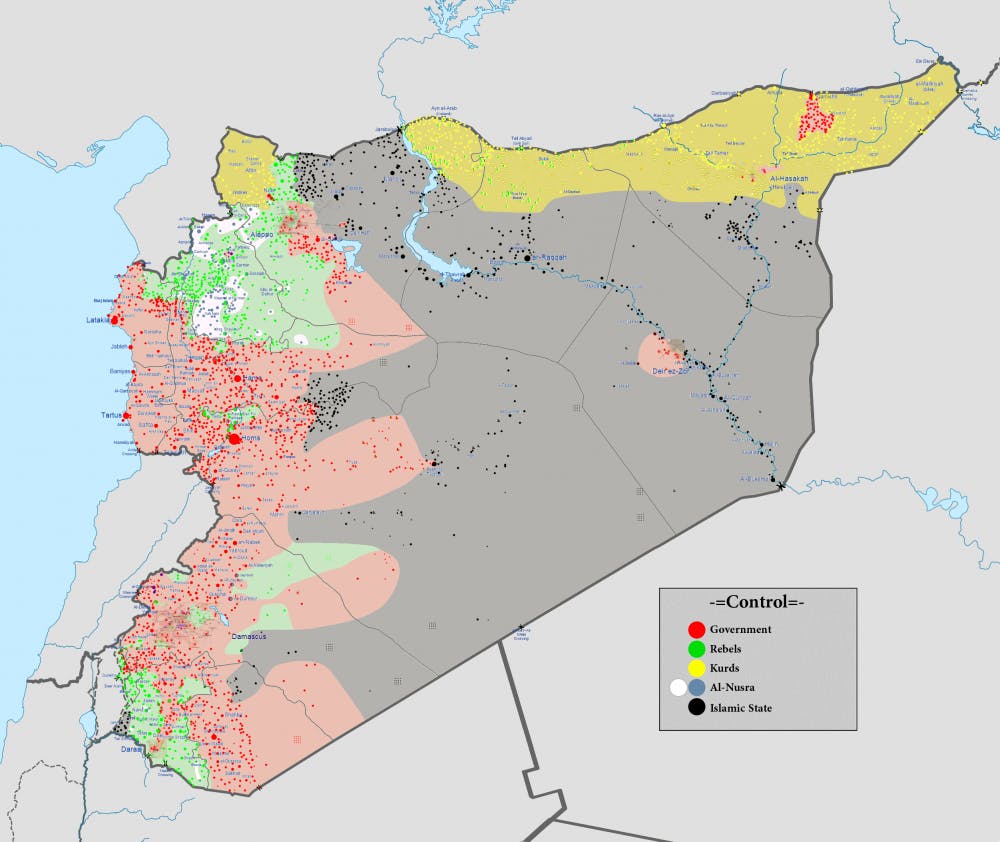Seven Hopkins students traveled to Washington, D.C. on Friday to attend an advocacy training program, #Advocate4Syria Lobby Day, held by the Syrian American Medical Society (SAMS). The group of seven spent one day away from their regular classes to meet with staff members on Capitol Hill and learn more about the Syrian civil war from doctors who worked on the ground there treating victims in an active war zone.
They got the chance to speak with leaders and legislators about their concerns with the situation in Syria. The civil war has been ongoing since the Arab Spring protests gripped the Arab World in 2011 and has pitted those loyal to President Bashar Al-Assad against radical Islamists and moderate opposition groups backed by Western nations, including the United States. Many of the students had never lobbied for an issue that was dear to them before attending the event. Sophomores Christine Adib, Julia Bateh and Molly Brambil were among those who attended the #Advocate4Syria Lobby Day. The hashtag in the event’s name expressed the organizer’s desire to create a trending topic on multiple social media platforms.
Dr. Ahmad Tarakji, president of SAMS, and Dr. Majed Abou Ali, a Syrian doctor, made the opening speeches and explained why Syrians need better civilian protections. The Chairman of the Foreign Affairs Committee of the U.S. House of Representatives, Ed Royce (R-CA), was also present. The pervasive conflict, currently in its fifth year, has killed over 500,000 combatants and civilians who have been targeted with chemical weapons, explosives and fragmentation devices that are aerially dropped on population centers. The war has so far displaced half of Syria’s population, many of whom are now fleeing to Europe in search of asylum and safety.
While the students in the group were motivated by the humanitarian struggle in Syria, Abid has a personal connection.
“After that summer, after all of the stuff that is going on in Syria — my family is from Syria — it gave me a bigger picture and really changed my perspective. I personally know Syria to be a very great country,” Adib said.
After the initial speeches, the various volunteer lobbying groups split up to talk to their elected representatives.
“You would have a 15-to-20-minute meeting with a staff member or a senator. Mostly, it was with staff members because the senators were on recess. We were briefed on some main points we should hit. It was just us Hopkins kids. We traveled together. By the end, we had a routine. None of us had any lobbying experience,” Bateh said.
The seven Hopkins students refined their persuasion skills throughout the day. They gave representatives some background information about the crisis and delivered a list of “asks” that included demands for immediate civilian protection through a no-fly zone, the resettlement of 100,000 Syrian refugees in the United States and increased funding for humanitarian relief during the fiscal year ending in September 2016. In addition to advocating for the thousands of Syrians who have fled the country or lost their lives in the conflict, the students practiced advocacy skills and issued talking points to Congressional staff members.
Adib, Bateh and Brambil said that last April’s unrest in Baltimore spurred their desire to become more politically and socially involved on and off campus. They said that this desire inspired them to organize a special Hopkins team to promote humanitarianism on Capitol Hill for SAMS.
“I don’t believe that what we did on Friday will result in legislation, but that doesn’t mean that we can’t gain something from it. In going to lobby on Capitol Hill for a day, I think I learned more in eight hours than I did in classes,” Brambil said.
The students in the group initially organized the trip through their mutual friendships. Not everyone had a major related to the work they engaged in on Friday, but the participants felt that it was important to apply their passions outside of the classroom. Furthermore, they said that the ideals that the University hopes to instill in its students connects to the problems that Syrians face in one of the worst humanitarian disasters since World War II. In relating their experience to undergraduate life at Hopkins, the four asserted that students weren’t using their full potential to affect change outside of campus.
“Besides the International Studies component, it is a huge medical issue. You have 12 million civilians in need of medical treatment and it’s something that Hopkins should be into,” Adib said. Bateh felt that too many Hopkins students are disengaged from world issues, despite attending a University that has an international reputation.
“These are events that we educated students should be involved in, even if you have a slight interest in it. Even to just go see it, students here don’t take advantage of it. It’s important to realize that it is okay to put class time and study time behind real life experiences,” she said.
Although not experts on the Syrian conflict, the students felt that the SAMS advocacy program gave them fresh insight into the need for ordinary citizens to get involved in policy-making. Essential medical resources, including those of SAMS, have endured attacks on their facilities and workers throughout the conflict.
The unique opportunity allowed them to speak personally about a world issue that will only continue to grow. Thousands of refugees have overwhelmed European nations in recent months while risking their lives during the passage. “This problem has been five years ongoing. A lot of Senators wanted to do something about this, but we need to push it on them,” Abid said.





